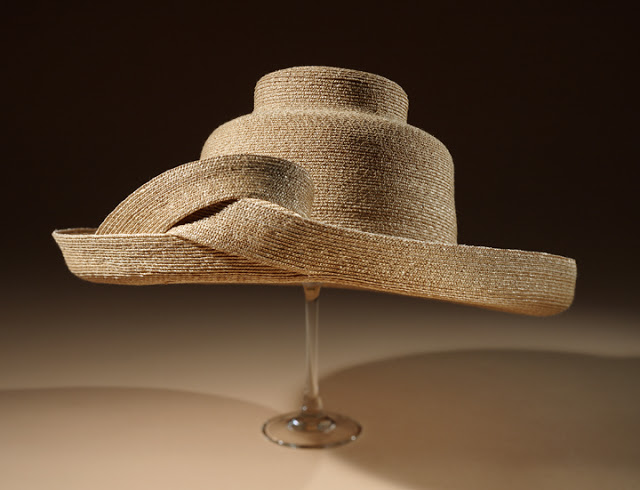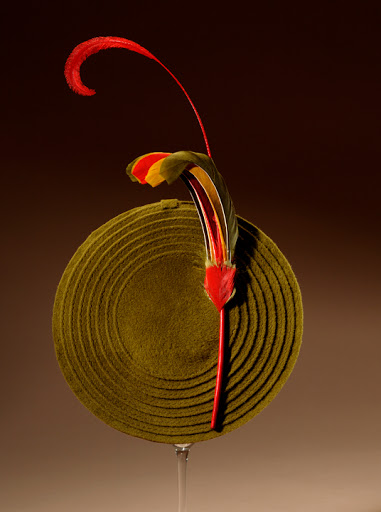Handmade Holiday: Ignatius Hats would love to make your head look snazzy
Local hat-making duo covers the heads of many a character in nationally-renowned movies and shows, but they’ll cover your humble noggin, too.

Be honest–at any royal weddings you’ve seen in your lifetime, what’s the one thing you remember? Maybe a lace dress, maybe a horse-drawn carriage, but definitely, definitely all the rad hats.
What is up with us in the U.S. of A.? Why don’t we wear more elaborate hats? Our footwear gets pretty bizarre, but for the most part our heads are bare.
So boring. Ignatius Hats is here to help, with incredibly detailed and custom-made hats. Owners Ignatius Creegan and Rod Givens know they serve a niche market, but they’re fine with that. It just means their customers are more appreciative and less likely to treat a hat as a disposable accessory.
The more you look through the things they can do, the more you start to think that this might be a great gift for someone you know who likes to be a little daring with their accessorizing. You also might start to believe that you’re in the wrong profession, because millinery looks super, super fun.
I asked Ignatius Creegan some questions about hats–the making, the wearing, the picking out.
1. What was it about hats that attracted you?
Initially, I was attracted to hats’ transformative powers. A hat can make you look and feel different, and each hat has a little bit of that attractiveness that makes you appear to be more than your normal self. I liked that there were so many ways to make a hat–a hat can be made out of anything, and the traditional range of materials is huge.

There is art in choosing a hat as well as making it. It’s particularly interesting to help someone choose a hat that will suit their face and their style.
A hat can be practical, or it can be art. My initial attraction to hats was invigorated by the fact that no one in Richmond seemed to be making hats on a studio scale. I had been casting about for a few years after college making glass works, metal work, and stone carvings, but hats were different. It was clean and safe work, and I had practically no competition, aside from the overwhelmingly ubiquitous style of not wearing a hat.
2. And why the specific hats that you make? They’re so artful and unique–where do you get your inspiration?
When I first became interested in hats, I was making things to wear to keep warm in my stone carving studio at the old Richmond Dairy. It was an unheated building, and it got stone cold (literally). My first hat was fur, cut up from a thrift store coat. I thought that I would become a furrier, and this was a small project that I could manage. But furs were on the way out, and I had this small collection of hats, so I began to make some patterns.

Ignatius Creegan and Rod Givens, during a trip to Esperaza, France to view an old hat factory. Here, they’re probably being inspired to incorporate some Roman architecture elements into a hat. I would buy that hat.
I still like to make practical hats, though my partner, Rod Givens, excels at making small artworks that you wear on you head. From my studio window, I could see the stage door of the Empire Theatre on Broad Street in Richmond. I knocked on that door, and asked to meet the Costume Designer at Theatre IV. Tom Hammond looked over my work, and began to give me the hat work that came through the theatre. My first job was Hansel and Gretel— we did most of the fairy tales, and I made a lot of interesting hats and crowns. I think that the early theatrical work hat set the tone for drama and comedy in my interpretation of headwear, and I still look to big house dramas for inspiration. Period stories always include great hats. I’m lucky to be able to see the old styles on characters who are wearing the entire ensemble of clothes from the period, and be able to see them move about in appropriate settings.
3. Is it tough to be a hat maker in the US? Who are your customers? Who’s buying beautiful, striking hats these days?
When I started in 1985, the hat trade was at a very low population . You wouldn’t see people wearing hats on TV, not in fashion magazines, and many people did not have a hat wardrobe. But it wasn’t difficult to find customers. I could only make hats in small collections, so I only needed buyers by the dozens every few months.
“I think it’s a good idea to wear hats when its cold, when it’s sunny, and when you want to look good.”
There has always been a small percent of the population that loves hats, and I found some of those people. I find theatrical millinery work keeps me going in a different way, it enables me to slow down and do handwork that can take days to complete, with a level of detail that is seldom appropriate for modern dress. We just completed a collection of hats for the PBS drama _Mercy Street_1 that I made mostly without the use of sewing machines. For period work, I like to make a hat that looks real, sewn in the way hats would have been constructed at the time, with correct materials and methods.
4. Should we all be wearing more hats? Viewing your products made me feel very hat-deficient. What does a hat say about a person?
I think it’s a good idea to wear hats when its cold, when it’s sunny, and when you want to look good. I should be wearing more styles of hats. But I get into habits, and don’t always make myself a new hat. Often I snag the “second” hat, the nicked-up hat, or the pattern test version of a hat.
For many years though, I was in a market that has been driven by women, so I wasn’t making a lot of men’s styles that I could choose from. Now with three apprentices to help us, we are taking a serious look at menswear, and we’ve started to produce some samples.
5. Who are some of your own favorite makers?
As far as hatmakers go, I am most impressed with Rod Givens, my partner. He is a painter, and he is a great trimmer and hatmaker. My apprentices are all showing promise, too. I don’t keep up with current hatmakers–there aren’t that many of them, so I don’t come across their work often. I do admire Lilly Dasche and Sally Victor from the 1930s.
— ∮∮∮ —
Meet Ignatius, see the hats for yourself, and let him help you figure out what looks best on you. It’ll all go down at Handmade Holiday 2015 on December 5th at Hardywood from 11:00 AM – 5:00 PM. If you can’t make it, you can see some of his and partner Rod Givens’s work at various national and regional art shows.
- Mercy Street is a Civil War hospital drama that premiers on PBS in January 2016. ↩
-
Recommend this
on Facebook -

Report an error
-

Subscribe to our
Weekly Digest





There is 1 reader comment. Read it.